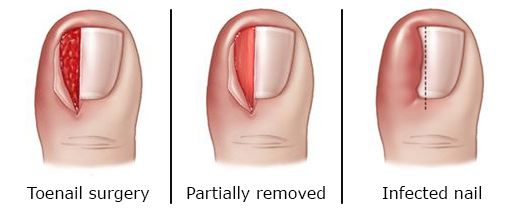What you need to know about Ingrown Toenail Treatments
An ingrown toenail, also known as onychocryptosis, is a condition that occurs when the edge of the nail grows into the skin of the toe. It can result in swelling, pain, and redness. Sometimes, you can take care of ingrown toenails on your own. However, if the pain is spreading or severe, you may need medical treatments. You may also want to promptly seek medical treatments if you have diabetes, a compromised immune system, or poor circulation.
The treatment option for ingrown toenail may include lifting the nail, removing some of the nail (partial nail removal), and removing all of the nail and tissue (total nail removal). The type of treatment you will undergo depends on your specific condition.

What does the Procedure Involve?
Lifting the nail
If your problem is mild, meaning the nail is only slightly ingrown and there is no pus, your doctor may be able to carefully lift the edge of the ingrown nail and place a splint, dental floss, or cotton under it. The splint, dental floss, or cotton will set the nail in a new position, separating the nail from the overlying skin and helping it to grow above the skin.
Partial nail removal
Partial nail removal may be needed for a more severe ingrown toenail. This means that there’s redness, pain, and pus.
During partial nail removal, your doctor will cut away the sides of the nail so that the edges are completely straight. Then, a piece of cotton or a splint is placed under the remaining portion of the nail in order to stop the ingrown toenail from recurring. In some cases, your doctor may also use a compound called phenol to treat your toe. Phenol can keep the nail from growing back.
Total nail removal
If you experience ingrown toenails repeatedly on the same toe or if your ingrown toenail is caused by thickening, your doctor may remove your whole nail along with the underlying tissue (nail bed).
To start the procedure, your doctor will loosen the skin around and from the nail. Then, the nail is separated from the skin by using a special tool under the nail. Your doctor may use a laser, a chemical, or other methods to remove the nail.
All procedures are performed under local anesthesia, which is injected directly into the toe. With local anesthesia, you will be awake but your toe will be numbed, so you will not feel anything throughout the procedure.
How Long Should I Stay in the Area?
You are allowed to leave the hospital on the same day of your ingrown toenail treatment. However, it is recommended that you stay in the area for a few days following the surgery, at least 3 days, to let your toenail to recover before you travel home. It may be uncomfortable for you to travel long distances during your initial recovery time.
What’s the Recovery Time?
Recovery can be different for everyone. On average, it takes about four to six weeks to heal after partial nail removal and around 10 to 12 weeks after total nail removal. During the recovery time, you should be able to walk and carry on your life as normal after 3 days of rest. However, you need to avoid strenuous activities, including running and jumping for 2 weeks. It is also advisable that you avoid taking part in sports activities and dancing until you have fully healed.
What About Aftercare?
Your doctor will give you specific aftercare instructions, which may include:
-
If your doctor gives you pain reliever make sure to take it as directed. Your doctor may also give you oral or topical Medication (antibiotics) which helps get rid of the infection.
-
Keep your foot raised for a day or two to allow your toe to heal properly.
-
Wear special footwear for the first few days. Then, you can slowly start wearing sandals or open-toed shoes until the area feels better.
-
Avoid picking at the wound.
-
Keep the wound clean and dry, except when cleaning the area or showering.
-
Soak your toenails with salt water daily.
What’s the Success Rate?
Ingrown toenail treatment is a safe procedure. According to the National Health Services (NHS), partial nail removal is 98% effective in preventing future ingrown toenails. It is important, however, to remember that every type of surgery carries some possible risks, such as toenail deformity, infection, and anesthesia complications. Serious complications are typically rare and untreated ingrown toenails carry a much higher risk of complications.
Are there Alternatives to Ingrown Toenail Treatment?
If your ingrown toenail is not infected, you should be able to treat it with home remedies, such as keeping your feet dry, soaking your feet in warm water, using a wedge to lift your nail and apply antibiotic creams. However, if your ingrown toenail is infected, there’s no alternative than to get the medical treatments mentioned above.
What Should You Expect Before and After the Procedure
Before ingrown toenail treatment, you may experience swelling, tenderness, hardness, redness, bleeding, pain, and pus coming out of your toe. In some cases, the condition can be serious and cause an infection in the bone, leading to foot ulcers and tissue decay at the site. After treatment, all of the painful symptoms you experience before will be relieved and the chance of the condition to complicate will be reduced.
For an in-depth analysis of an Ingrown Toenail Treatment, watch this short video.
To check prices or to book an Ingrown Toenail Treatment, in Thailand or anywhere else in the world, head on over to MyMediTravel now!

